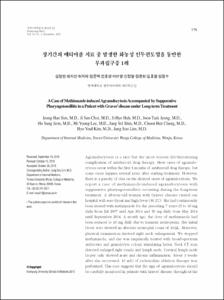장기간의 메티마졸 치료 중 발생한 화농성 인두편도염을 동반한 무과립구증 1례
- Journal Title
- Keimyung Medical Journal
- Issued Date
- 2015
- Volume
- 41
- Issue
- 2
- Keyword
- Graves' disease
- Abstract
- Agranulocytosis is a rare but the most serious life-threatening
complication of antithyroid drug therapy. Most cases of agranulocytosis
occur within the first 3 months of antithyroid drug therapy, but
some cases happen several years after starting treatment. However,
there is a paucity of data on the delayed onset of agranulocytosis. We
report a case of methimazole-induced agranulocytosis with
suppurative pharyngotonsillitis occurring during the long-term
treatment. A 48-year-old woman with Graves’ disease visited our
hospital with sore throat and high fever (39.2℃). She had continuously
been treated with methimazole for the preceding 7 years-15 to 40 mg
daily from Jul 2007 until Apr 2014 and 50 mg daily from May 2014
until September 2014. A month ago, the dose of methimazole had been
reduced to 10 mg daily due to transient neutropenia. Her initial blood
tests showed an absolute neutrophil count of 40/μL. Moreover, physical
examination showed right neck enlargement. We stopped methimazole,
and she was empirically treated with broad-spectrum antibiotics and
granulocyte colony stimulating factor. Neck CT scan detected enlarged
right tonsils and lymph node. Cervical lymph node biopsy only showed
acute and chronic inflammation. About 3 weeks after she recovered,
10 mCi of radioiodine ablation therapy was performed. This case
suggests that the sign of agranulocytosis should be carefully monitored
in patients with Graves’ disease, throughout the course of treatment with methimazole, even under the long-term
therapy.
- Alternative Title
- (A)case of methimazole-induced agranulocytosis accompanied by suppurative pharyngotonsillitis in a patient with graves' disease under long-term treatment
- Publisher
- Keimyung University School of Medicine
- Citation
- 심정한 et al. (2015). 장기간의 메티마졸 치료 중 발생한 화농성 인두편도염을 동반한
무과립구증 1례. Keimyung Medical Journal, 41(2), 176–182.
- Type
- Article
- Appears in Collections:
- 2. Keimyung Medical Journal (계명의대 학술지) > 2015
- 파일 목록
-
-
Download
 장기간의 메티마졸 치료 중 발생한 화농성 인두편도염을 동반한
무과립구증 1례.pdf
기타 데이터 / 1.36 MB / Adobe PDF
장기간의 메티마졸 치료 중 발생한 화농성 인두편도염을 동반한
무과립구증 1례.pdf
기타 데이터 / 1.36 MB / Adobe PDF
-
Items in Repository are protected by copyright, with all rights reserved, unless otherwise indicated.